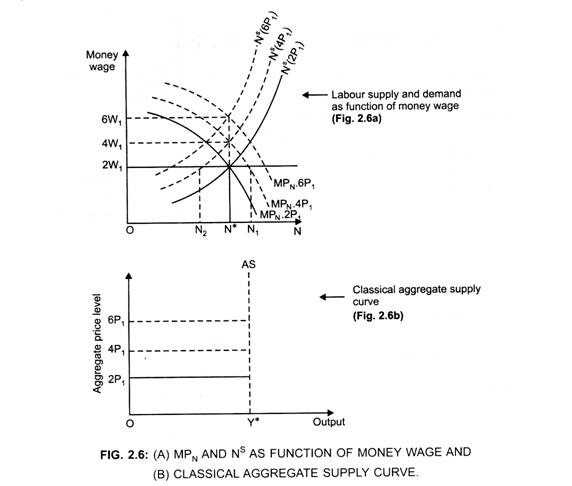Profit maximization condition of a Perfectly Competitive Firm:
MPN = W/P …from (2.3)
As money wage is constant, increase in price will lead to a decrease in (W/P)
ADVERTISEMENTS:
As a result, demand for labour by the firms will increase and output will increase.
At Price → 2P1
Money Wage → 2W1
Employment → N*
ADVERTISEMENTS:
Output → Y*
When Price Changes:
When price increases to 4P1, with money wage remaining constant (2W1), then Employment will increase from N* to N1 (Fig. 2.6) because an increase in price leads to decrease in (W/P).
But money wage will not remain constant at 2W1, as output and labour input is varied because
ADVERTISEMENTS:
At Price → 4P1; With money wage → 2W1
(W/P) falls. Thus, decrease in real wages because of increase in price from 2P1 to 4P1 with money wage remaining constant at 2W1 will lead to a decrease in the supply of labour.
As a result, supply curve of labour will shift to left from Ns (2P1) to Ns (4P1) (Fig. 2.6).
Supply of labour will decrease from N* to N2 because the workers realise that their real wages have decreased. Therefore, they are willing to work less.
As a result, there will be an excess demand for labour (that is, shortage of labour) = N1 N2.
Due to excess demand for labour, money wage will increase because some firms will increase the wages to bid workers away from other firms.
This increase in wage will continue till the equilibrium is not reached in the Labour Market.
This occurs at the money wage → 4W1
Increase in money wage = Increase in price
... (W/P) remains constant
ADVERTISEMENTS:
Employment comes back to the original level.
... Output supplied at price → 4P1 is Y* (same output supplied at price → 2P1)
Thus, Aggregate Supply (AS) curve is vertical (Fig. 2.6), which shows that even if price increases, output level will not change [because 2W/2P = 4W1/4P1 = 6W1/6P1].
ADVERTISEMENTS:
Output will change only if price and wages do not increase in the same proportion.
Thus, vertical Aggregate Supply curve illustrates the supply-determined-nature of output.
